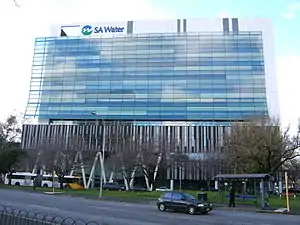SA Water
SA Water is a government business enterprise wholly owned by the Government of South Australia.

History
SA Water was established by the proclamation of the South Australian Water Corporation Act 1994 on 1 July 1995.[1] Prior to this its predecessor was known as Engineering and Water Supply Department (E&WS). E&WS evolved from the Waterworks and Drainage Commission, which was established in 1856, 20 years after European settlement.
Key infrastructure projects SA Water has undertaken include:
- Morgan – Whyalla pipeline (1940–1944)[2]
- Mannum – Adelaide pipeline (1949–1955)[2]
- Hope Valley Reservoir (commenced work 1869)
- Mount Bold Reservoir (commenced work 1932)
- Bolivar Waste Water Treatment Plant (commenced work 1961)
- Adelaide Desalination Plant (2008–2012)[3]
- North South Interconnection System Project (NSISP) (2010–2013)
Assets and infrastructure
SA Water manages, maintains and operates (with the assistance of its partners) assets worth $13 billion. These include:
- More than 26,000 km of water mains[2]
- More than 8,700 km of sewer mains
- More than 180 km of recycled water mains
- 30 water treatment plants[4]
- 24 wastewater treatment plants[5]
- More than 16 reservoirs with a total capacity of almost 200,000 megalitres[6]
- Terminal Storage Mini Hydro, a 3MW electricity generator powered by water flowing from Anstey Hill to Hope Valley.
SA Water also owns desalination plants at Lonsdale and Penneshaw.[7][3]
Location and staff
SA Water employs more than 1,500 people and has its head office in Victoria Square in Adelaide (SA Water House). Staff are also located across South Australia including offices in Mount Gambier, Berri, Mount Barker, Port Lincoln and Crystal Brook as well as Victoria and New South Wales. SA Water's customer service centre operates out of the head office in Victoria Square.[8] SA Water House is also the headquarters of the Australian Water Quality Centre (AWQC).
Customers and community
SA Water provides water and wastewater services to a population of approximately 1.5 million people across South Australia. In 2011/12 the total volume of water delivered was 208,144 ML and the average residential consumption per household was 164.3 KL.
SA Water runs a school education program called SA Water Brainwave that is offered free to South Australian schools.[9] SA Water also offers free community tours of wastewater and water treatment plants.[10] In 2013, SA Water opened the Kauwi Interpretive Centre at the Adelaide Desalination Plant which is also open for visitors.[10]
References
- "Archived copy". Archived from the original on 2 April 2018. Retrieved 16 August 2018.CS1 maint: archived copy as title (link)
- "Major pipelines". Sawater.com.au. Retrieved 16 August 2018.
- "Adelaide Desalination Plant (ADP)". Sawater.com.au. Retrieved 16 August 2018.
- "Water Treatment". Sawater.com.au. Retrieved 16 August 2018.
- "Sewage Treatment". Sawater.com.au. Retrieved 16 August 2018.
- "Reservoirs". Sawater.com.au. Retrieved 16 August 2018.
- "Penneshaw Desalination Plant". Sawater.com.au. Retrieved 16 August 2018.
- "Day in the life in the SA Water Customer Service Centre". YouTube. 23 May 2013. Retrieved 16 August 2018.
- "Brainwave Learning Program". Sawater.com.au. Retrieved 16 August 2018.
- "Tours & Presentations". Sawater.com.au. Retrieved 16 August 2018.
External links
- SA Water homepage
- "Water bills error affects thousands of SA customers". Abc.net.au. 31 May 2013. Retrieved 16 August 2018.